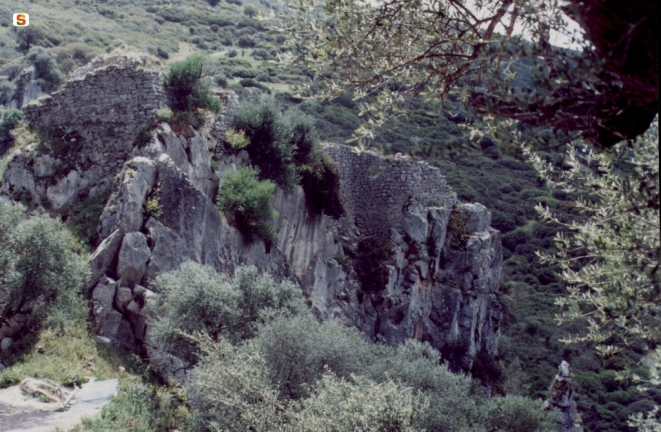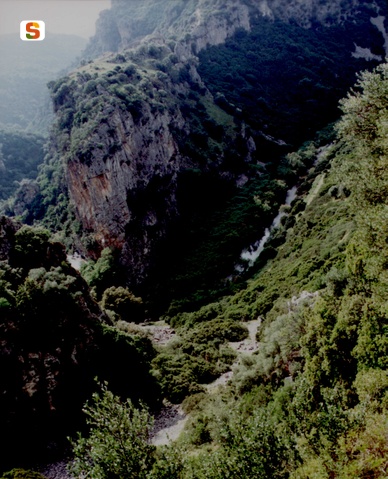The Castle of Medusa between history and legend
There is the history, actually little, and the legend, a lot; and there is a bridge between history and legend, too…
Despite several legends, news of historical character about the Castle of Medusa are few. In this journey, we will discover all the real and fantastic features of this extraordinary isolated place.
We can begin with the history. In the middle of the canyon of Laconi and Samugheo Mountains, between Samugheo and Asuni, you can glimpse a rock that sinks; a big monolith that erects on the scrub and on the wood. There is a small road in the woods, that is a crossroads of precipitous dark paths and that, finally, leads to a cave that joins itself with the enormous rock. A bridge is the only entry for whoever wants to be on top of the rock.
The Castle of Medusa rises up in a wide valley, in an unusual position, because it has no purpose of control, but, only of security. Indeed, it is incredibly hidden. The floor of the Castle is cluttered of some trees and bushes. Various ruins arise, as a bequest of a building that once was certainly Majestic. There are some breaches that sink into the land and that, through a precipitous canyon, lead to underground rooms.
Establishing the antiquity of this Castle is an arduous challenge. It was dated back to the Middle Ages, through these caves that allow to imagine some narrow jails. That is the origin of its appalling name, dated back to the Greek mythology and the discover of more than one Roman coin, into the caves, that refer the first core of its ancient framework exactly to the Roman Epoch.
Until here the history of the Castle, that shows a little of its ancient splendor, but, that still hides, through its perimeter, its dilapidated stones and its narrow position, much more than that is shown to the human eye. The passage from the history to the legend is not drastic, but, accompanied by an odd and ambiguous happening.

A certain Francesco Perseu, native of Asuni, a bandit imprisoned in a jail of Piedmont, told that once, after a state of being in hiding, bumper into the Castle and saw with his own eyes, going down through a tunnel, a room full of jewels and precious stones, gold and lots of things with a big value.
So, he exchanged that treasure with his freedom, with the aim of leading there whoever could make him free again. Persuaded the officials of the Government and came to the area where the Castle rose up, he did not find either the secret passage or the treasure and he came back to the prison with an addition of other three years of detention to the conspicuous punishment. The aim of the bandit was logically the escape, when he would have arrived at the destination, acute expert of those cliffs and of those gorges, but, he was not able to find the good moment for completing his plan.
But, there was the history of that utopian treasure, existed really or invented. But, it is here that the myth grasps with power. The anecdote that was mentioned stays there, as a bridge of union between history and legend, the same small bridge that links the big rock, where the Castle rises up, to the rest of the world.
Now we penetrate into the true legend beginning from the name. An ancestral, poetic, deep, magic, full of meanings name: the magnificent monster of the Greek mythology, Medusa exactly.
Understanding how the Greek myth came to the isolated cavities of Sardinia is a complex procedure. A castle of which they do not know much, such that they suspect even its real existence, needed a magic name. And Medusa appears with its head covered with snakes and its gaze that turns to stone. Still along the wake of the legend, it had a big treasure, closed into a treasure chest, submerged into the dark of one of the caves and for avoiding that this treasure was removed to it, it invented a second treasure chest alike the previous, into which it closed an exterminator fly that would have destroyed the whole mankind: sa musca macedda.
Two identical treasure chests. One next to the other. Nobody opened one of those. Everyone were besieged by the doubt and terrorised by the tragic mistake that they could do, if they had opened the wrong treasure chest.

There is the Sardinian mythology that still interests people; tradition tells that this place was a house for ghosts and demons, that preferred the unusual, inaccessible and isolated positions and these features made the Castle of Medusa a place suitable for their reproduction. Finally, other legends establish magic links between Medusa and the janas.
Medusa was not only the name with which the Castle of Samugheo was known. Locally, it was known as the Castle of Orgia, too. According to Dolores Turchi, Medéusa in the Greek language means "lady, defender". Suitable connection with the Sardinian Goddess Mother. Mother, Lady and obviously defender.
Here the circle is closed and we can find a natural and right, we can say, connection with that name. Indeed, Medusa can be also a symbolic representation of the feminine cult with a direct symbiosis with water, a fundamental ritual in Sardinia, practiced by the antiquity. For inciting this theory, there is the Arascixi Stream that flows slowly under the rock, and a kind of ancient cistern for the deposit of water, among the ruins of the Castle.
History and myth with the real-fantastic trait d’union of the history of the bandit who wanted to escape and all the magic and ritualistic allusions that are offered by the history of that place. Today, the Castle of Medusa is an arduous location with a difficult access, but, thanks to that, it is fascinating and it was able to keep an ancestral charm that endures for a lot of time.